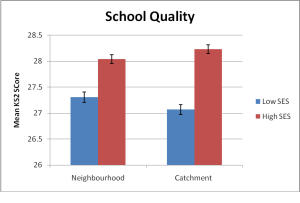Author: Simon Burgess
Teacher performance pay without performance pay schemes
Amid the macroeconomic gloom, the Autumn Statement contained a line about teachers’ pay. The School Teachers’ Review Body recommends “much greater freedom for individual schools to set pay in line with performance”. Consultations and proposals are expected in the near future.
But simply giving schools the freedom to do this may be a rather forlorn hope of anything much happening. It is not clear that there is a substantial demand from schools for performance-related pay (PRP) schemes that has only been thwarted by bureaucratic restrictions. It is hard to see high-powered, tough-minded PRP schemes being introduced by more than a handful of schools, not least because we have not seen large scale deviations from national pay bargaining in academies in England despite their new freedoms to do so.
If that path seems unpromising, there are other ways of facilitating a greater reflection of performance in pay, discussed shortly. But first – is PRP for teachers a good idea in the first place? Does it raise pupil attainment? What are the ‘side effects’?
This is a question that economists have produced a good deal of research on. And to summarise a lot of diverse work briefly, the international evidence is mixed. Those on both sides of the argument can point to high quality studies by leading researchers that find substantial positive effects, or no effects. In both cases, interestingly, there appeared to be little evidence of gaming or other unwanted effects of the incentives.
There is little evidence specifically for England. Our own research found a substantial positive effect of the introduction of a PRP scheme, but given the varied results found elsewhere it would seem unwise to place too much weight on this one study. The underlying performance pay scheme was poorly designed but nevertheless had a positive effect on the progress of pupils taught by eligible teachers relative to ineligible ones.
And design is key. There are many reasons why a simple high-powered incentive pay scheme might be detrimental to pupil progress, which we have discussed here and here. These include the fact that teachers have multiple tasks to do, the problems of measuring the outcomes of some of those tasks, the complex mixture of team and individual contributions, and the potential impacts on implicit motivation. The overall message is that incentives work, but schemes have to be very carefully designed to achieve what the schemes’ proponents truly intend.
There is another way to facilitate a closer link between pay and performance that does not require any school to introduce a performance pay scheme.
Published performance information in a labour market can change the way that the market rewards that performance. The critical features are first that the organisation’s own output depends in an important way on this performance characteristic of an individual; second that the organisation has some discretion in the pay offers it can make to new hires; and thirdly that the performance information is public – is available and verifiable outside the current employer. In this case, the pay structure of the market will reflect the performance rankings: high-performing individuals will be paid more.
In teaching, the first two of these three conditions are met: teacher quality matters hugely for schools, and schools have some discretion over pay. Now, suppose we had a simple, useful and universal measure of each teacher’s performance in raising the attainment of her pupils (obviously we don’t at the moment; I come back to this below), and that this was published nationally, primarily for the attention of Headteachers. The idea is that Headteachers trying to improve the attainment of their pupils would be on the look-out for high performing teachers when they had a vacancy to fill. Armed with this performance information, they might try offering a higher wage (or something else – it doesn’t have to be money) to tempt them to join their own school. Equally, the teacher’s current school may respond by raising the offer there. Over time, this process will tend to raise the relative pay of high-performing teachers relative to low-performing ones, whom no-one is trying to bid for.
This idea should not be a strange one. A number of professions have open measures of performance. Just today it is reported that performance measures for more surgeons will be made public in the summer of 2013; this is already true for heart surgeons.
It is well-known that PRP does two things: it motivates and it attracts. The outcome for pay described here will tend to make teaching more attractive to people who are excellent teachers and less attractive to those who aren’t.
There are a number of problems with this idea, though perhaps less than might appear at first glance. First, it could be argued that a performance measure derived from teaching in one school is not relevant to teaching in another school. Obviously each child and each school is unique, but it seems very unlikely that there is no commonality of context between one school and the next. Observation suggests this: teachers moving from one school to another are not counted as having zero experience, and Headteachers are often appointed from outside a school.
Second, there might be a fear that the teacher labour market would become chaotic, with everyone churning around from school to school in search of a quick gain. We have to recognise that there is substantial turnover of teachers now < http://www.bristol.ac.uk/cmpo/publications/papers/2012/wp294.pdf >. But the main point is that it does not require much actual movement to make the market work. Schools can make counter offers to try to retain their star teachers and the end result is the same – higher salaries for high-performing teachers.
Third, any measure would be noisy, partial and imperfect. Of course, all such measures are. Whether a measure is perfect is not really the question, the question is how noisy and imperfect is it, and whether it contains enough information to be useful. One advantage in this case is that the consumers of these performance indicators are the people best able to judge their usefulness and their shortcomings: Headteachers. If such metrics are not useful, Headteachers will simply ignore them; there would be no compulsion to use them. Even in labour markets with some of the most detailed and finely measured performance indicators (for example, football or baseball) there are many moves between employers that do not work out. It is worth re-emphasising that these performance measures are bound to be imperfect and incomplete, but broad measures of performance may nevertheless be very useful.
There are useful parallels to be drawn from another profession: academics. For academics, the combination of very detailed and public performance information and a context where research performance matters a great deal to universities seems to have had a substantial effect on academics’ pay.
The Research Assessment Exercise (RAE) and more recently the Research Excellence Framework (REF) have made a strong research performance very important to a university’s standing and its income. But the critical factor for academics is that an individual’s research performance is public knowledge, through very detailed recording of the impact of their research papers. Departments and universities aiming to improve their ranking seek out star researchers and attempt to bid them away with higher salaries (plus other things such as research facilities). These offers may well be matched by their current employer, but the end result is that salaries now seem to be much more closely correlated with research productivity than before the RAE/REF (I say “seem” as there does not appear to be any evidence on this, so this is casual empiricism). This is a lot of what drives many young researchers to put in very long work hours: having a paper published in a top scientific journal early in a career has a substantial lifetime payoff even in a world with few or low-powered incentive schemes. If you check out academics’ websites you will invariably see their academic output prominently displayed.
Again, an important feature is that these indices of research output are largely consumed by other academics who are aware of their strengths and weaknesses. So although they are far from perfect, they are used by precisely the people best placed to calibrate their usefulness appropriately.
If we are to go down a path of tying teacher pay more closely to performance, and yet respect the rights of increasingly autonomous schools to determine their own pay systems, then this might be an option to consider. The challenge is to devise a measure that is simple, useful and universal. It would measure the progress made by the pupils that teachers taught, it would have to deal with normal variations in performance by averaging over a number of classes and a few years, and be on a common metric. This is not straightforward, but if it gave rise to a robust broad measure of performance it could form a part of performance pay for teachers, and performance management more broadly. It could also have substantial effects on the pay of high-performing teachers.

